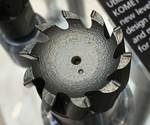Video: Redesigned Milling Cutter Demonstrates Design Possibilities of AM
Topology optimization plus a material change realize an 80 percent reduction in mass.
Sandvik Additive Manufacturing has assisted sister company and cutting tool maker Sandvik Coromant in the redesign of a milling cutter to be made through additive manufacturing (AM). Making the tool additively allows for substantially lighter weight, and light weight will lead to more productive milling because the lighter cutter can be run at higher spindle speeds without vibration. The new milling cutter is 80 percent lighter than the original tool made conventionally.
In this video, I talk through some of the steps Sandvik took toward realizing that weight reduction, from lattices to topology optimization to a change in material. The last of these steps is perhaps the most striking. Titanium is not typically thought of as a material for making cutting tool bodies, but it was the right material for making this tool additively. AM not only enables these radical design changes, it also enables the exploration of these changes by making iteration easy.
This clip is one of several short videos Additive Manufacturing filmed while covering the recent Formnext show. Here are a few others:
Transcript:
Pete: It’s Pete Zelinski with Additive Manufacturing Magazine at Formnext, Frankfurt, Germany. Sandvik, the materials company, is here, sister company to Sandvik the cutting tool maker.
Here is a milling cutter redesigned for additive manufacturing using expertise this Sandvik, the Sandvik for additive manufacturing, was able to bring to this project.
A real commercial product that will be introduced dramatic improvement in this milling cutter. Very heavy, take my word for it. First attempt to make it lighter: lattice structure. Okay, the better solution was “Why don’t we try to topology-optimize it: a form that maximizes performance for minimal mass?” Try that. That also was okay and an incremental improvement.
The next step beyond that: topology optimization plus a change in material. The material is now titanium, meaning less material, even less mass, and further iteration got it even lighter.
This version, 20% of the mass of the original enables higher speed, faster spindle speed, meaning that it’s even more productive than the original despite having fewer cutting edges.
And, another advantage of additive manufacturing seen here is the freedom to iterate and iterate and iterate to get just the optimal design. Even this isn’t the final. I understand there have been, like, 25 design versions of this to get absolutely the perfect milling cutter in terms of performance plus low mass.
Related Content
-
3D Printed Cutting Tool for Large Transmission Part: The Cool Parts Show Bonus
A boring tool that was once 30 kg challenged the performance of the machining center using it. The replacement tool is 11.5 kg, and more efficient as well, thanks to generative design.
-
3D Printed "Evolved Structures" for NASA Exoplanet Balloon Mission: The Cool Parts Show #61
Generative design creates stiff, lightweight brackets for EXCITE mission monitoring planets orbiting other stars. The Cool Parts Show visits Goddard Space Flight Center.
-
Seurat: Speed Is How AM Competes Against Machining, Casting, Forging
“We don’t ask for DFAM first,” says CEO. A new Boston-area additive manufacturing factory will deliver high-volume metal part production at unit costs beating conventional processes.














